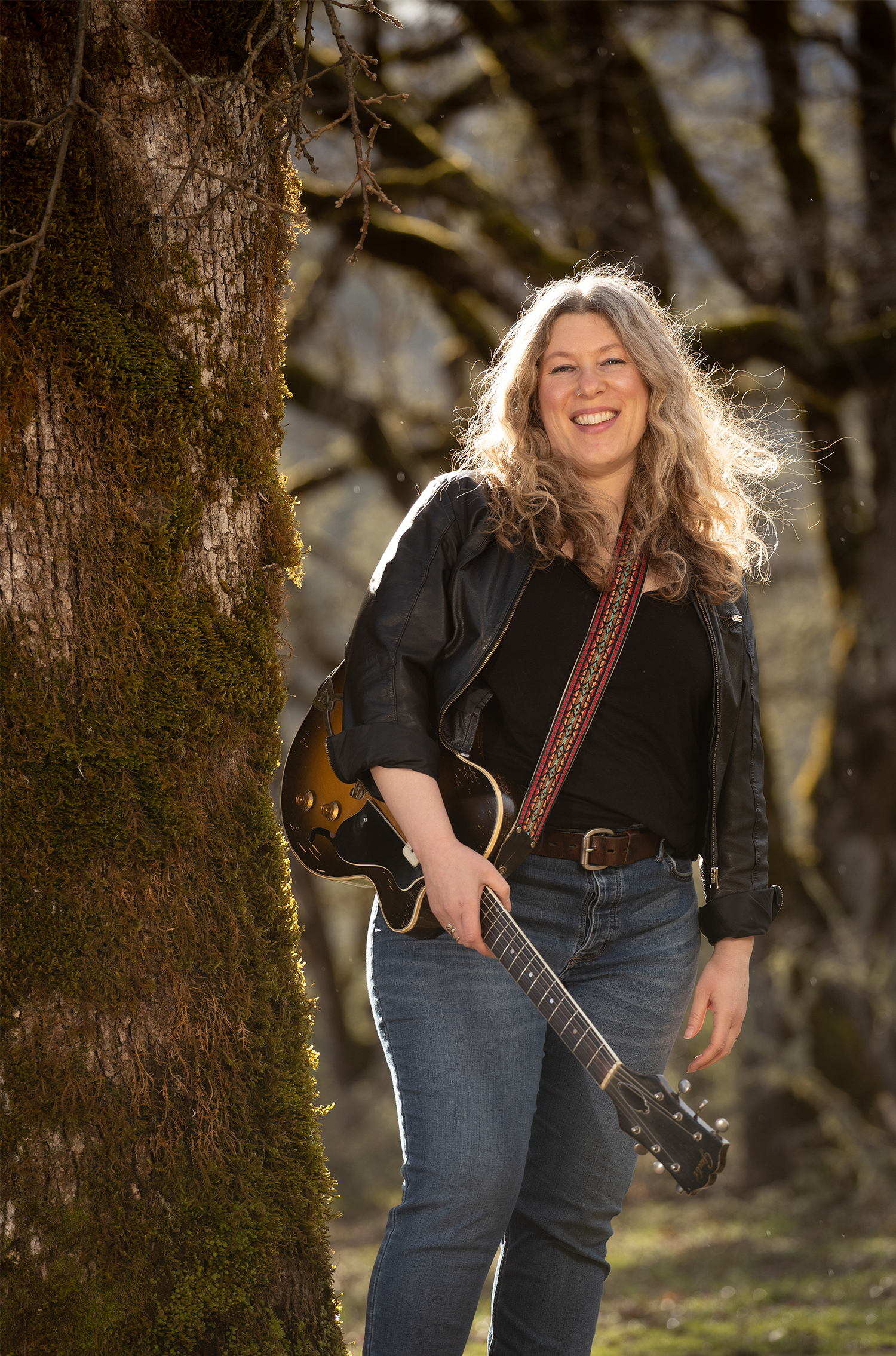Guitar Hero

It’s not easy to get to Todd Clinesmith, but it’s easier than getting one of his custom guitars. But the long list of names on his waiting list proves his instruments are worth the long wait.
Story by Dick Baltus, Photos by Thomas Boyd
To find one of the most sought-after guitar craftsmen in the country, drive east on Highway 138 to Idleyld, turn left and follow a teeth-rattling, kidney-dislodging dirt road in the general direction of the middle of nowhere.
You won’t quite get there, but by the time you reach Todd Clinesmith’s shop you’ll swear you’re close.
You’ve got to really want to see Clinesmith to see him, and you’ve got to really want one of his guitars to get one. His instruments are in such demand that buyers will typically wait a year for delivery of a Clinesmith resonator guitar (or Dobro). And, while he can turn around a lap steel guitar in six to eight weeks, double- and triple-neck versions on stands and with pedals or other accessories are likely to require a year-long wait as well.
But there’s no shortage of customers willing to wait, especially since he’s the only luthier around still making the 1940s-50s style steel guitars for which he’s known.
“I call it a niche within a niche,” Clinesmith says.
The Southern California native got interested in building instruments after he started playing at age 18. “I’d always wanted to build an instrument,” he says. “I had sort of a creative background, and I was always playing with my dad’s tools.”
Todd Clinesmith and a couple of his coveted steel guitars.
Clinesmith decided he’d start with a dulcimer, a stringed instrument that’s played by picking and using a noter, similar to a slide. He was a fan of the old Foxfire books, collections of magazine articles written in the 1960s by Georgia high school students who would interview local people about Appalachian culture. When he ran across an interview of an old-timer who made dulcimers, he ordered a copy of the plans for the instrument, assuming he would be out of luck, given it was now the early ’90s.
To his surprise, the plans actually showed up, and Clinesmith was, in a manner of speaking, in business (it would still be almost a decade before he’d start selling his instruments).
After building a couple dulcimers, Clinesmith turned his attention to the Dobro, an acoustic guitar played with a slide and self-amplified by an aluminum cone under a round metal coverplate. As a player, he had switched from acoustic guitar, playing fingerstyle Delta blues and bottleneck slide, to Dobro, which allowed him to expand his sound more melodically than the bottleneck would allow.
Now he wanted to build one, or one and a half actually. He needed one guitar to make his mistakes on, and another to not repeat them on. Without any luthier education or training, he was winging it. Clinesmith tore apart his own guitar to see how it was constructed, then dove in, applying some basics he’d learned from a guitar construction book.
It took him about a year to finish his first guitar, and a year later Clinesmith had made a couple more. By year three, he says, “I was building a pretty good resonator.”
There were only a few luthiers making the unique guitars, and Clinesmith realized his were comparable in quality to any out there. In 2001, he decided to give it a go as a full-time business.
“I started hitting all the music festivals, setting up booths and bringing my guitars around,” he says. “Before the end of that summer I had about a year-long waiting list, and it kind of took off from there.”
While Clinesmith had been playing in bands and becoming a pretty accomplished bluegrass-style Dobro player, he was increasingly drawn to the sounds produced by the steel guitar. Soon it would become his instrument of choice. He was particularly enamored of the tone he was hearing on recordings from the 1940s and ‘50s, and he was frustrated that he wasn’t able to reproduce it on any of the production steel guitars he had played.
“I was going through a lot of instruments trying to find a sound I had in my head,” Clinesmith says. “I bought quite a few Fenders, but the sound was real thin. It drove me crazy when I’d hear these old recordings with this fat, rich sound that I couldn’t get.”
That sound, he learned, was being produced by guitars made by an innovator named Paul Bigsby. Well-known today for his electric guitar vibrato tailpieces, Bigsby also invented the solid-body electric guitar and was the father of the steel guitar.
The first steel guitar record Clinesmith bought was “2 Guitars Country Style,” by Speedy West and Jimmy Bryant. It was the first modern pedal steel guitar recording and the musicians were playing Bigsby instruments. (In an interesting twist, Clinesmith is now restoring West’s steel guitar for a collector.)
By the time Clinesmith started playing steel, Bigsby’s instruments had become hard to find and appropriately expensive. But through a stroke of serendipity, Clinesmith learned a Chicago-based friend had in his possession many of Bigsby’s tools and parts, which had been gathering dust in a closet since 1966, when Bigsby sold his business to a former Gibson guitar executive.
After striking a deal with his friend, Clinesmith flew to Chicago, then drove back home with his prized possessions and started making steel guitars.
“I’m really recreating a lot of what Paul did,” he says. “I put my own unique stamp on the guitars, but I’m working from his designs. The old Bigsby guitars are museum pieces, in a way, so I’m happy getting that sound out there again.”
As are his customers. While you won’t see many steel guitars on MTV, it remains a popular instrument in many musical genres, including bluegrass, country, western swing and Hawaiian. And the best players are as particular about the sound of their instruments as Clinesmith was his.
Several who have purchased his guitars, while not “Eric Clapton famous,” as Clinesmith puts it, are well-known in the steel guitar world. They include Chris Funk, of The Decembrists and Black Prairie (a past guest at Music on the Half Shell); John Ely and Bobby Black, both former members of Asleep at theWheel (Black also played with Commander Cody) and Mike Neer, out of New York, whose acclaimed 2016 release, “Steelonious” featured steel-guitar-centric covers of jazz great Thelonius Monk tunes.
“What Neer effectively does is take an instrument associated with, in order, Hawaiian luau, Santo and Johnny’s 1959 Sleepwalk and every Jackson Browne song David Lindley played on, and use it to transform the Monk book in a most wonderful and delightful way,” C. Michael Bailey wrote for All About Jazz.
Neer says he first connected with Clinesmith “when I heard Todd was going to be making Bigsby-styled guitars, which some of my favorite players, like Speedy West, Buddy Emmons, Vance Terry and Joaquin Murphy, played at one time. I had to get in on placing an order.”
According to Neer, Clinesmith’s instruments embody the best qualities of 1930s-era Rickenbacker steels, his personal gold standard. “I’ve owned many steel guitars, but nothing I’ve played has captured the magic of Rickenbacker the way Clinesmiths do,” Neer says. “Todd’s instruments are the epitome of classic American workmanship. The tone and feel are outstanding.”
Located on opposite sides of the country, Neer and Clinesmith have never met, but they’ve developed a strong friendship and working relationship over the last decade. Neer even credits his guitar maker with revitalizing a struggling career.
“At one time I was on the precipice of quitting, because I felt stuck in a place that I didn’t want to be musically and was not surviving financially and artistically,” Neer says. “A steel guitar that Todd sent me was the catalyst for everything changing. I felt empowered with a sense of nothing to lose, so I quit playing guitar and focused all my energy on steel.”
Clinesmith and his wife Shelly, a Winston native, moved from California to Glide in 2004 and from Glide to the top of that unforgiving dirt road four year later. From that beautiful and preternaturally quiet spot, he makes about 40 steel guitars a year and another four to six Dobros.
A lap steel guitar requires about 30 hours of his time, while the “handful” of double and triple necks on stands (consoles) he makes can take up to 100 hours. Prices range from $1,500 for a typical lap steel to us much as $5,800 for a triple-neck console. Dobros take up to 100 hours, start at $4,200 and have gone as high as $7,800.
Clinesmith's lap steels (above) require about 30 hours of labor while a triple neck can take 100 hours and comes with a year-long wait time.
Clinesmith uses a variety of woods to make his instruments, including Hawaiian koa and Oregon myrtlewood, but his favorites are western curly maple for his resonators and eastern birdseye maple for the steels.
About half the time, Clinesmith’s customers know the wood they want; he makes the choice for the other half. “They either have a wood type they’re attracted to or they have a sound they like, and I’m able to recommend woods based on that.”
Most of Clinesmith’s business these days comes through word of mouth or customers finding him online. He hasn’t had to schlep guitars around music festivals since that summer of 2001. “Since then I’ve always had a backlog,” he says.
He isn’t terribly nostalgic about his journey through instrument making. That first Dobro? It survived several moves until one day he was burning some scrap wood, and the old guitar caught his eye. Soon it was ashes. He tried to burn the dulcimer too, but Shelly wasn’t having it.
She took a clock off a wall in the Clinesmith home and hung the instrument in its place.
“I think I liked the clock better,” he says, laughing.
Maybe now, but chances are the old dulcimer will win out over time.










